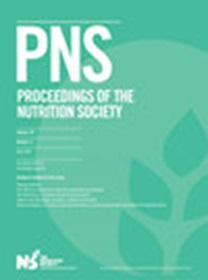血清中 25- 羟维生素 D 浓度与需要入院治疗的呼吸道感染之间的关系:英国生物库队列中的种族群体分析
IF 7.6
2区 医学
Q1 NUTRITION & DIETETICS
引用次数: 0
摘要
研究发现,维生素 D 状态与呼吸道感染 (RTI) 风险成反比(1)。据报道,与白人相比,英国一些少数民族群体缺乏维生素 D(血清 25- 羟基维生素 D (25(OH)D) 浓度为 25 nmol/L)的风险较高(2, 3)。然而,英国不同种族的血清 25(OH)D 浓度与 RTI 发病率之间的关系仍不清楚。本研究旨在调查英国不同种族群体中血清25(OH)D浓度与RTI住院可能性之间的关系。本研究使用英国生物库的数据开展了一项嵌套病例对照研究,该生物库拥有50万成年人的血清25(OH)D数据和相关记录中的住院病例数据。在纳入分析的36772名参与者中,12638人(34%)为白种人,10311人(28%)为亚裔,7138人(19%)为黑人,4034人(11%)为其他族裔,2651人(7%)为混合族裔。在完全调整模型中,与血清25(OH)D浓度为15 nmol/L(严重缺乏)的参与者相比,血清25-49 nmol/L、50-74 nmol/L和≥75 nmol/L的参与者发生RTI住院的几率在统计学上显著降低,几率比(OR)分别为0.53(95% CI:0.37,0.75)、0.61(95% CI:0.40,0.92)和0.54(95% CI:0.30,0.97)。在亚组分析中,与不缺乏维生素D的人群相比,缺乏维生素D(25 nmol/L)的少数民族和白人更有可能因RTI住院,OR值分别为1.36(95% CI:1.02,1.81)和2.03(95% CI:1.30,3.17)。在英国成年人中,血清 25(OH)D 浓度高于 25 nmol/L 与 RTI 住院的可能性较低有关。尽管与白人相比,缺乏维生素 D 的少数族裔患 RTI 的可能性较低,但这一发现在白人和少数族裔群体中均有体现。有必要开展进一步的研究来验证这些发现,并探索不同种族群体中维生素 D 状态与 RTI 之间的关联机制。本文章由计算机程序翻译,如有差异,请以英文原文为准。
Association between serum 25-hydroxyvitamin D concentrations and respiratory tract infections requiring hospital admission: analysis of ethnic groups from the UK Biobank cohort
Vitamin D status has been found to be inversely associated with risk of respiratory tract infections (RTIs)(1) . It varies by ethnicity, with several ethnic minority groups in the United Kingdom (UK) reported to be at a higher risk of vitamin D deficiency (serum 25-hydroxyvitamin D (25(OH)D) concentrations <25 nmol/L) compared to their white counterparts(2, 3) . However, the relationship between serum 25(OH)D concentrations and incidence of RTIs by ethnicity in the UK remains unclear. This study aimed to investigate the association between serum 25(OH)D concentrations and likelihood of hospitalisation for RTI in UK ethnic groups.A nested, case-control study was conducted using data from UK Biobank, which has data for 500k adults for serum 25(OH)D and hospital episodes from linked records. Binary logistic regression models were used to explore the association between serum 25(OH)D concentrations and likelihood of RTIs overall, and by ethnicity.Of the 36,772 participants included in the analysis, 12,638 (34%) were white Caucasian, 10,311 (28%) Asian, 7,138 (19%) black, 4,034 (11%) other, and 2,651 (7%) of mixed ethnicity. In fully adjusted models, compared to participants with a serum 25(OH)D concentration <15 nmol/L (severe deficiency), those with 25-49 nmol/L, 50-74 nmol/L, and ≥75 nmol/L were found to have statistically significantly lower odds of RTI hospitalisation, with odds ratios (ORs) of 0.53 (95% CI: 0.37, 0.75), 0.61 (95% CI: 0.40, 0.92) and 0.54 (95% CI: 0.30, 0.97), respectively. In the subgroup analysis, ethnic minorities and white individuals with vitamin D deficiency (<25 nmol/L) were more likely to be hospitalised with RTI compared to those that were not deficient, with ORs of 1.36 (95% CI: 1.02, 1.81) and 2.03 (95% CI: 1.30, 3.17), respectively. This association was not statistically significant within ethnic minority subgroups when analysed separately.Serum 25(OH)D concentrations above 25 nmol/L are associated with lower likelihood of RTI hospitalisation among UK adults. This finding was noted across white and ethnic minority groups, although ethnic minorities with vitamin D deficiency had a lower likelihood of RTIs compared to white individuals. Further studies are warranted to validate these findings and explore the mechanisms underlying the association between vitamin D status and RTIs in different ethnic groups.AcknowledgementsThis project was conducted using the UK Biobank resource under project 15168.
求助全文
通过发布文献求助,成功后即可免费获取论文全文。
去求助
来源期刊
CiteScore
15.50
自引率
0.00%
发文量
190
审稿时长
6-12 weeks
期刊介绍:
Proceedings of the Nutrition Society publishes papers and abstracts presented by members and invited speakers at the scientific meetings of The Nutrition Society. The journal provides an invaluable record of the scientific research currently being undertaken, contributing to ''the scientific study of nutrition and its application to the maintenance of human and animal health.'' The journal is of interest to academics, researchers and clinical practice workers in both human and animal nutrition and related fields.

 求助内容:
求助内容: 应助结果提醒方式:
应助结果提醒方式:


